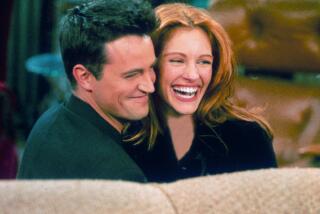ABC’s Arledge proved ‘TV genius’ is not an oxymoron
- Share via
RooneRoone
A Memoir
Roone Arledge
HarperCollins: 432 pp., $25.95
*
As he was dying of the cancer that had returned after eight years, Roone Arledge worked on the manuscript of his memoir every day, succumbing to the illness last December, at age 71. Although he didn’t live to see the publication of “Roone,” a fascinating, incisive chronicle of his four decades in network television, his legacy is about as impressive as anyone could hope for.
Arledge didn’t just work in network news; he was a larger-than-life figure, a pioneer who inspired copycats through his visionary strategies and programming. Although he disliked being called a “legend in television,” he was exactly that. Arledge created lively newsmagazine shows such as “20/20” and “PrimeTime Live” long before networks went overboard and used such programs as cheap filler (“60 Minutes” had been first, but Arledge reinvented the news magazine show concept). Most notably, he founded “ABC’s Wide World of Sports,” the longest-running sports program in history, and “Monday Night Football.” He also produced 10 Olympic broadcasts.
Before Arledge, sports programming was virtually nonexistent. Arledge believed fervently and unapologetically in its grand possibilities. “What television ought to be striving for,” he writes, “is to give the fan the best seat in the house, with intelligent commentators describing and explaining what was going on.... I wanted to make the game more intimate, and a lot more human.” Sports presented “life condensed, all its drama, struggle, heartbreak, and triumph embodied in artificial contests.”
Considering people like his then-wife, Joan, who were not sports fans but who “enjoyed a good show,” Arledge set out to provide them with spectacle as well as scores. He started with NCAA football games, adapting some techniques already used in covering political conventions and other kinds of television coverage -- and inventing some techniques of his own. Wanting to present sports on a large canvas, he created the use of multiple cameras to capture crowd scenes, cheerleaders, referees and close-up reactions of coaches and athletes -- as well as footage of the town in which the game was played. And he created the now-ubiquitous use of instant replay. Arledge aimed to add a bit of show business to sports, and he did.
Over the course of his career, Arledge won more than 30 Emmys and was admired even by his biggest competitors. He’d worked his way up from earning $66 a week as an NBC stage manager to becoming head of ABC Sports, network president and finally chairman. It’s clear from Page 1 of this memoir that being humble didn’t seem to come naturally to Arledge. But surely a healthy amount of brashness was needed to rise up through the ranks of network television.
Admirably, no matter how high the stakes, Arledge never seemed afraid of following his instincts, even when others were certain he would fail. Well aware that Howard Cosell was someone who “at times made you want to strangle him,” Arledge also knew that he was unforgettable. When it was clear that Cosell might not get along with a co-announcer for Monday Night Football, Arledge decided to make the most of it: “[What] if we turned the announcers’ booth into a kind of stage set, where an engrossing and possibly funny and certainly controversial drama might play out between the players?”
The most compelling dramas in this book play out between the network stars, including Harry Reasoner, Barbara Walters, Peter Jennings, Diane Sawyer, Ted Koppel, Hugh Downs and Sam Donaldson. The pairing of Walters and Reasoner was hardly one of Arledge’s triumphs. Watching them co-anchor the ABC Evening News, he concedes, was like “arriving for a dinner party at the house of a couple trying to maintain a truce in front of the world while waiting to claw each other’s eyes out.”
The network news stars may be commanding and authoritative on television, but behind the scenes, a few are portrayed, unsurprisingly, as infantile prima donnas. Arledge, adept at defusing bad behavior, treats them mostly with paternal affection and handles their outbursts good-naturedly. Reasoner insisted that his decorator-designed office be precisely the same dimensions as Walters’; she demanded petty stipulations in her contract, which included having a say in the type size of her name on-screen.
Although “Roone” is not especially well-written, the author has a breezy, conversational style that makes you feel less like you are reading and more like you are listening to a great raconteur tell his tales over a few pints of beer at the local bar. Are we in the hands of a reliable narrator? It’s hard to say, yet Arledge seems as candid about his own shortcomings as he is about the errors of others. Maybe television never really experienced a golden era, but “Roone” makes you think it did and inspires nostalgia for a time when shameless exploitation -- and an utter lack of originality -- were not network TV’s defining characteristics.
More to Read
The complete guide to home viewing
Get Screen Gab for everything about the TV shows and streaming movies everyone’s talking about.
You may occasionally receive promotional content from the Los Angeles Times.






